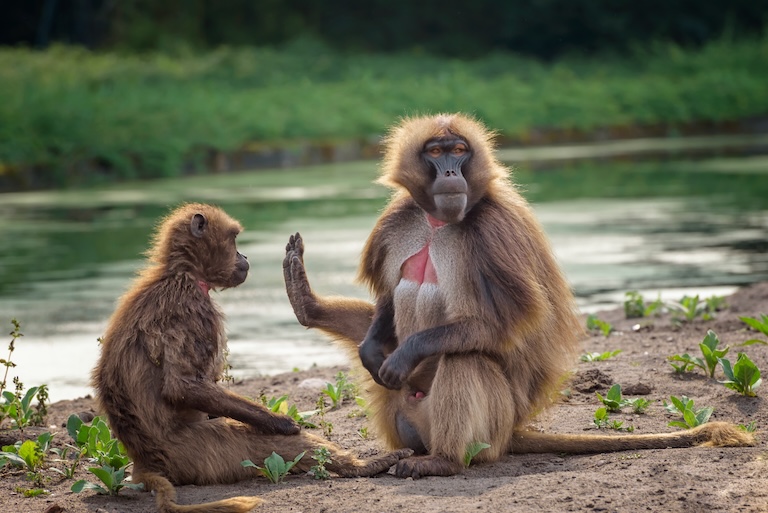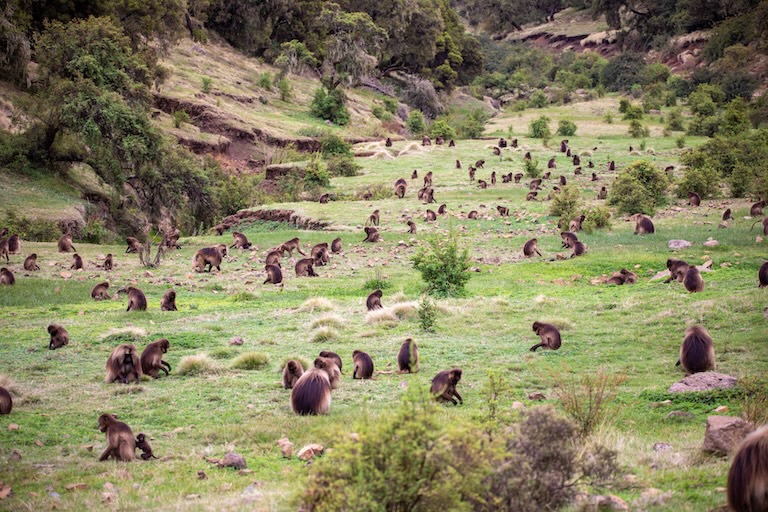Gelada Profile
With all of the bad news coming out of Ethiopia over the past decades, it would be easy to overlook the country entirely, but this would be a tragic mistake.
Ethiopia is one of the oldest independent countries in the world, and as such, has one of the most ancient alphabets, the oldest churches, some of the most ancient hominid fossils ever found, and within its borders sit over one million square kilometres of landscapes ranging from vast salt plains, through volcanic vents, savanna, lush rainforests to alpine slopes.
Within these habitats, there are animals found nowhere else on earth.
One such species, the gelada, is the world’s most terrestrial (non-human) primate.

Gelada Facts Overview
| Habitat: | Mountainous grassy highlands |
| Location: | Endemic to Ethiopia |
| Lifespan: | Around 15 years |
| Size: | 75 cm (30 in) long |
| Weight: | Males up to 21kg (46lb) |
| Colour: | Golden brown to dark brown |
| Diet: | Mostly grasses, also fruit |
| Predators: | Domestic dogs, leopards, servals, hyenas, bearded vultures |
| Top Speed: | Unknown |
| No. of Species: | 1 |
| Conservation Status: | Least Concern (IUCN) |
With a name like an Italian ice cream, this is by no means a sweet animal and should be licked only by professionals and with extreme caution.
These are very baboon-like monkeys but with a sense of high fashion. Their enormous manes and colourful chests are clues to their high-altitude success, and a large male gelada is nothing to be trifled with.
Geladas are intelligent, complex, social animals, and they can only live in the mountains of Northern Ethiopia. As such, their protection is important, and while they’re currently listed as of Least Concern globally, some subpopulations are in much greater danger.
Interesting Gelada Facts
1. They’re not baboons (but maybe they should be)
The gelada looks like a baboon that knows how to dress. Unlike their lowland cousins, these guys have thick fluffy manes and bright colouration on their chests.
Like baboons, they’re terrestrial, although geladas rarely retreat to the treetops. They spend most of their time on the ground, eating grass.
While it was placed inside its own genus in 1979, it’s still up for debate whether or not that was a good idea, and it may come about that geladas are reunited with the baboons in the Papio genus once more.
As of now, though, it’s the only one left in the Theropithecus, along with a couple of extinct species. There are two official subspecies, known as the Northern and Southern (or Eastern) gelada.

2. They’re high-altitude monkeys
All this extra fluff they carry is an adaptation to living at such impressive elevations. Gelada country begins at 1800 meters, 500 meters above the highest point in Britain, and extends up into the chilly climes of 4,400 meters, 400 meters shy of the highest peak in the Alps.
This has some perks to it. Firstly, there aren’t as many predators up there, which allows these monkeys to sit on their arses all day on the grass. Secondly, it’s not as dry as lower altitudes, meaning there’s more to eat.
Geladas are the only primates known to eat grass this much. 90% of their nutrition comes from blades most of us couldn’t digest.
But the cold means they have to carry around that big fur coat, and sitting on their butts means they have to show their fertility in other ways. While baboons like a nice pink bum, geladas have brought the sexual signage up to their chest.
This is what’s given them their other common name. 1
3. Bleeding heart monkeys
Grass-eating has also given this monkey some unique adaptations. They’re as effective at chewing roughage as a plains zebra and have specialised teeth fit for purpose.
They also have a unique shuffle that allows them to squat over the grass while eating. As mentioned, this covers up the bum patch, so the gelada has a bright, hourglass-shaped patch of skin on its chest. This is usually vivid red in males, and duller in non-oestrous females.
That means it’s a sign of virility and power in the male gelada and a sign that a female is ready to get down. It’s also thought to play a role in thermoregulation, as it can be flushed with blood to act as a radiator. 2
4. They socialise in the morning and evening
At sunrise they mingle on plateaus, catching up on the day’s plans. The middle of the day is spent eating foraging and eating, coming together again in the evening, before descending to treacherous cliff faces to sleep.
Their predators are typically leopards, hyenas and domestic dogs, but bearded vultures and servals will also take a young gelada, so their abodes need to be hard to access for all threats.
Grooming is one key way that geladas bond, but they also have a surprisingly diverse set of calls.
5. They have extremely complex vocalisations
Unlike many social primates, dominant males often allow their predecessors to stick around, acting as babysitters for the young they had sired before the change in leadership.
Reproductive units like this are one of two common social groups, the other being bachelor male bands, who roam around looking to start families.
When a bachelor male finds a group of females, he may or may not have their support in overthrowing the resident male, but the females will not move between clans, and stick together for life.
This relative social complexity is, in part, facilitated by the gelada’s vocal language. While this is dangerously understudied, it’s thought that gelada vocal communication is one of the most complex of its kind in the primates, and has been shown to follow some fundamentals of language. 3
6. Human-wildlife conflict is a problem for the Gelada
As Ethiopia’s pastoral range expands, conflicts are emerging between the monkeys and the humans. Geladas are shot, attacked by dogs, and displaced from feeding grounds to lower-productivity areas.
Pushing back against this, conservationists are focussing on income alternatives, better land planning, and community education.
It’s not currently known how many geladas remain, but from the 10,000 recorded in the ’70s, numbers have likely declined to an estimated 4,000 as a result of the human expansion. 4
7. They have a limited range
The laws of ecology show that organisms are constrained by their available niches. Most of the time, the potential niche of an animal is much larger than its “realised niche”, i.e., it’s constrained by external factors like predators, cliff faces, oceans, or highways.
This means that for threatened species, there are sometimes other places they can occupy, with a little help from conservationists.
It was once thought that the limited range of the gelada was a result of competitive pressure from the lowland baboons, who pushed the species to higher altitudes, but it’s now thought that despite living in a country bigger than Nigeria, this unusual monkey is inherently limited to a small portion of the Northern highlands.
Since the Holocene, there simply isn’t any suitable habitat remaining for the gelada outside of its current range. This makes the protection of this habitat so important to the success of the species. 5

Gelada Fact-File Summary
Scientific Classification
| Kingdom: | Animalia |
| Phylum: | Chordata |
| Class: | Mammalia |
| Order: | Primate |
| Family: | Cercopithecidae |
| Genus: | Theropithecus |
| Species: | gelada |
Fact Sources & References
- “Gelada”, African Wildlife Foundation.
- Patricia M. DeLacey (2022), “Assessing male gelada chest patches: color measurement and physiological mechanisms”, Springer Link.
- Morgan L. Gustison (2019), “The social functions of complex vocal sequences in wild geladas”, JSTOR.
- “Northern Gelada”, IUCN Red List.
- R. I. M. Dunbar (1992), “A model of the gelada socio-ecological system”, Springer Link.
